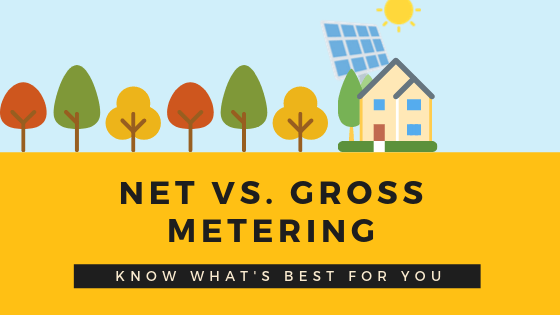It’s 2021 and generating electricity has become easier than ever, with solar energy. While solar power is economical, storing electricity is quite expensive. Therefore, solar panel systems are often connected to the electric grid. So, if you are an on-grid solar consumer, whose rooftop systems are connected to the grid, then there are two ways of metering defined by the government – Net Metering and Gross Metering.

Net Metering
This is an arrangement where the exported solar power is adjusted against the imported energy in the electricity bill. Basically, if the electricity consumed by the user is more than the amount of electricity produced, then it is imported from the grid. On the other hand, if the amount of solar power generated is more than what is consumed by the owner, then they get compensated for the excess amount. For instance, if you use 10 units a day while the electricity generated by your rooftop system is only 6 units, then it will reflect that 4 units have been imported from the grid. Meanwhile, if you use only six units and produce 10 units a day, you will be compensated for the excess power, depending on the rate that is fixed by the state’s electricity regulatory commission. This arrangement can be done on a monthly, half-yearly or annual basis.
Gross Metering
In gross metering, a consumer won’t be able to directly use the electricity that is generated by their rooftop system. This is because the solar power generated is directly fed to the supply grid through a different circuit and the energy required for consumption is imported from the grid. Now that there are two circuits, you will have two meters – one that records the consumption of electricity and the other for production. So, your bill for the amount of electricity you consume will continue to be the same. But, you will be compensated for the total number of units of solar energy produced and fed into the supply grid at a fixed feed-in-tariff (FiT) — the payment for electricity exported to the grid from a renewable energy source.
Gross Metering or Net Metering?
When it comes to financial benefits and high energy requirements, gross metering seems more beneficial than net metering because the return on investment (ROI) from gross metering is fixed and so is the amount of solar power produced and exported. The ROI from net metering arrangement depends on the amount of solar energy you save. If you’re looking at installing a system sometime soon, you might not want to opt for gross metering given its present tariff rates, which are quite high.
If you’re looking at long term benefits, it is advisable to choose net metering. With gross metering, you’ll be billed twice — once for your cumulative electricity consumption and then for the solar power your system generated and fed into the supply grid. In net metering, only one bill is generated and it gives you a measure of the total consumption of electricity as well as energy production.
However, it is recommended to get a cost comparison done from a professional before you make a purchase. At VEMCO Solar (Check out our solar story), we offer end-to-end EPC services to our valued clients. We have empanelled channel partners with the Ministry of New and Renewable Energy, Government of India, for solar PV rooftop, small power plant system integrators and installation. Guided by the knowledge gained by our parent brand VEMC over 72 years, our aim is to be by your side at every step of the way. VEMC is ISO 9001:2015 certified and a pioneer in the field of electromechanical engineering products, allied equipment, and services. Depending on requirement and feasibility, we offer off-grid, on-grid and hybrid solar system solutions as well. Please feel free to contact us on +91 98199 07445.

